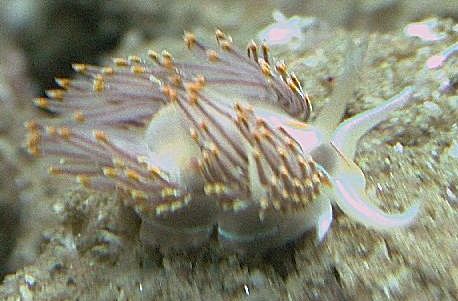Morgellon's disease in invertebrates?
Morgellon's is a skin disease characterized by patches of inflammation and multiple colored fibers apparently growing under the skin. By all accounts, these patches are extremely irritating, causing the patients to scratch them, often to the point of bleeding. Some physicians believe Morgellon's is an exotic new infectious disease, while others believe it's merely a delusion, the itching is psychogenic, and the fibers are merely dyed fibers derived from the patient's clothing. Morgellon's patients often report memory loss and other neurological symptoms.
Many years ago, I performed an experiment on a marine invertebrate, Hermissenda crassicornis, which is a sea slug (technically, a Nudibranch mollusc) found mainly in the Pacific Ocean. The experiment involved incubating the isolated nervous systems in artificial sea water for several days in a polystyrene 96-well plate. I was hoping to study the phosphoproteins, so I also added trace amounts of radioactive phosphorus (P-32). Unlike mammalian brains, the brains of these small, inch-long molluscs survive for as long as a week outside the body. The slugs don't have a circulating blood system, and they're small enough not to deplete the oxygen in the dish. So the cells remain viable and continue to grow throughout this period.
 Hermissenda crassicornis
Hermissenda crassicornis
After about one week, in several of the plates, I noticed tiny fibers that looked exactly like tiny pieces of wool. The fibers were usually white, but sometimes colored red or blue. Each fiber was always one continuous color. The fibers were entwined around the neurons in the dish, sometimes only one or two fibers per well, but occasionally almost covering the entire ganglion.
At the time, I assumed it was some type of contamination--perhaps one of my colleagues playing a prank, or someone wearing a wool sweater and carelessly getting fibers on my cultures. But there were no fibers in any of the empty wells containing sea water alone--only in the ones containing neurons that were growing. In about half the wells, neurons would normally start to grow, extending processes several millimeters away from the ganglion into the surrounding water. Fibers were visible in about one-fourth of these. Fibers were only seen in those wells in which neurons were sprouting. The largest fiber was about 2-3 millimeters long. It was unlike any type of contamination like mycoplasma or mold that would be expected to grow in cultured cells. And it certainly wasn't bacteria or ordinary sea algae. What it resembled more than anything else, I learned later, was Morgellon's fibers. Unfortunately, I didn't think to take a picture of them. As far as I was concerned, they were a nuisance because I had to discard all the samples, and the experiment was ruined.
Patients with Morgellon's report central nervous system disabilities including fatigue, metal confusion, short term memory loss, difficulty in concentration, depression, and changes in vision. The association of these fibers with isolated mollusc CNSs may provide a clue about this mysterious skin illness and its neurological complications.
References
[1]. http://www.cdc.gov/unexplaineddermopathy/
[2]. The mystery of Morgellons disease: infection or delusion?
Savely VR, Leitao MM, Stricker RB.
Am J Clin Dermatol. 2006;7(1):1-5. Review.
